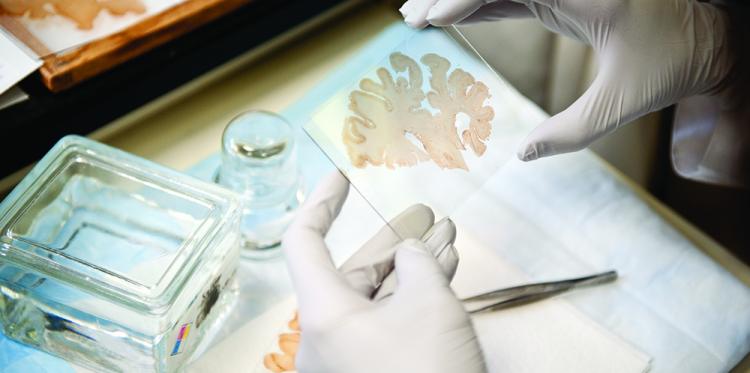July 26, 2017: Herb Weisbaum on 2pm KOMO NewsRadio 1000 am 97.9 fm
Weisbaum: A new study on the progressive brain disease CTE shows the neurological disease linked to head injuries in contact sports may be even more common than previously thought. It's the largest study of its kind to date. Researchers examined the brains of 200 dead football players ranging from high school to professionals and found that 87% of these ex-players have evidence of CTE. Among professional players, it was 99%. ABC’s Paula Faris says it's alarming even with caveats. Faris: “this study only looked at players who were exhibiting signs of CTE while they were alive, and that is a substantial caveat, but just this week player NFL David Bruton retired, walked away from the game, saying, quote: "I'd like to have my brain functioning when I'm older." We're going to talk more about this with Dr. Dirk Keene, Chief of Neuropathology at UW Medicine.
Hi, Dirk. Sounds like this is a big deal. It is?
Keene: It is absolutely a big deal. This is the largest study to date of football players looking at their brains for the pathologic changes that are essential for diagnosing CTE. The implications are concerning in that 99% of the professional football players evaluated in this study had evidence of this disorder. There are some important caveats which you highlighted, and the most important is that this population is not representative of football players in the NFL or football players in general because it's a highly selective sample, and so the players that died, whose brains have been donated, in many cases there was concern for CTE in those players, as such prospective randomized studies that are representative of the population of interest, whether that is professional football, college or any other, studies need to be done for us to really understand how many people who play football will get this disease, and what the consequences of that disease on the behavior and cognition in those players.
Is it a fair take away from this study that football helmets, despite all the improvement made over the years, are not doing enough to protect the brains of these players?
That's a great question. Clearly, players who have worn helmets have this disease. And so, by those criteria, I think that the answer would be yes. I think it's a lot to ask of a helmet—I’m not an expert in helmet design or physics, but the jarring you get in the brain in any kind of traumatic situation in sports or otherwise involves the brain moving around inside the head. Helmets are designed more for direct injury, and so it may be very difficult to design a helmet that will actually prevent this kind of pathology.
What would you say to parents who have kids playing some sort of contact sport, soccer football, or some sort of sport with a lot of head contact. What would you tell them?
I would say that we don’t have data to make recommendations. These were professional players and college athletes, mostly, and this was a convenient sample, and an autopsy is required for diagnosis. So again, we need much, much more study to understand what's happening at the youth sport level, whether football or other sports with relationship to developing this pathology, and we also don’t understand how this pathology relates to a person's function. There are some high school students in this study, and 3 of them have evidence of disease. But, it's not clear if those individuals would have progressed to develop more pathology, or if subjects in this study who didn’t have pathology would get it later. It's not clear what the implications are on their cognitive function and behavioral function, and so a lot more study is needed to make any informed decisions about youth sports. I would add that activity in any form is essential to a full and healthy life, and so I don’t want to discount the benefits associated with sports, contact sports or otherwise.
Dr. Dirk Keene is Chief of Neuropathology at UW Medicine, and I want to thank you so much for your time today.
Thanks, Herb.
__
Notes: This interview referred to the study out of Dr. Ann McKee's Lab at Boston University: Mez J et al., Clinicopathological Evaluation of Chronic Traumatic Encephalopathy in Players of American Football, JAMA. 2017; 318(4):360-370. doi:10.1001/jama.2017.8334
Dr. Dirk Keene served as one of seven neuropathologists on the first NIH national consensus forum on CTE in Washington D.C. in 2014, supported by the Foundation for Sports Health Research Program and the NFL. Keene is working with McKee on another project to quantify the pathological changes in CTE. Read more in our Q&A Tackling the Science of Brain Injury and Dementia Risk.





